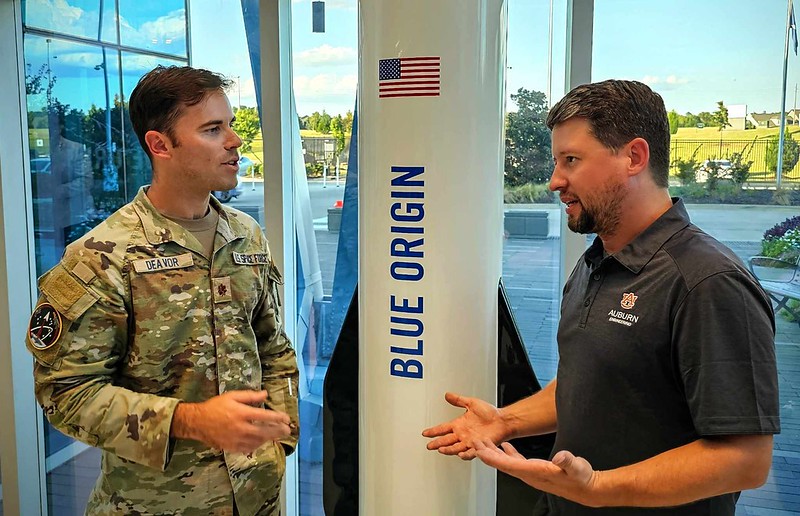content body
Auburn alumnus Timothy Monk can’t remember a time in his life when he didn’t love space.
“I wanted to be an astronaut from an early age,” he said. “That was the driving force behind a lot of what I did, so going to my beloved Auburn University and studying aerospace engineering seemed like an obvious fit for me.”
Monk is a director on the New Glenn mission management team at Blue Origin, the aerospace manufacturer founded by Amazon.com’s Jeff Bezos. He graduated from Auburn with a bachelor’s degree in aerospace engineering in 2005 and earned a master’s at the University of Colorado a year later.
He immediately joined NASA’s Constellation program, working to develop the rockets and spacecraft needed to replace the retiring fleet of space shuttles. When the program was canceled in 2011, Monk had mixed feelings.
“There is a range of emotions when a big program is canceled,” Monk said. “There’s a lot of sadness and uncertainty, but there’s opportunity as well and maybe a little optimism.”
For the aerospace industry, that optimism played out in the unexpected development of privatized space travel with the growth of large companies like Blue Origin and SpaceX and dozens of smaller companies. Monk worked on programs for Virgin Galactic, Vulcan Aerospace and Firefly before joining Blue Origin in 2017.

Monk (right) meets with a representative from Space Force to discuss a certification plan in Blue Origin’s Huntsville, Alabama, office.
As a director on the New Glenn program, Monk now leads teams working to develop and manufacture what is currently the largest launch vehicle in the world. Measuring 321 feet, New Glenn is taller than the Statue of Liberty, and its reusable first stage will have the capability of flying into space more than two dozen times.
“Historically, the aerospace industry has thrown away these very complex machines,” Monk explained. “Back in 2015, Blue Origin’s New Shepherd was the first launch vehicle booster to return to earth vertically in a landing zone and then head back to space again two months later. That program has reused two different boosters eight or nine times now.
New Glenn is stretching beyond that, and we plan to use our first-stage booster 25 times. We built this huge complex piece of machinery, so we try to get as much value out of it as we can. It increases our competitive position and lowers the cost for customers.”
Monk says the New Glenn launch vehicle will carry telecommunications and weather satellites into orbit for customers and is a cornerstone of Blue Origin’s plan to land on the moon later this decade. New Glenn also will launch Amazon’s Project Kuiper, a constellation of 3,236 satellites in low Earth orbit that will provide customers with space-based satellite Internet service.
Monk’s responsibilities include working with NASA and Space Force to certify the launch vehicle for their payloads and managing all regulatory compliance work needed to receive launch licenses from the Federal Aviation Administration. His main focus now is on the two contracts Blue Origin has with NASA.

Monk loves to return to campus to attend sporting events with his daughter and son.
The New Glenn rocket is scheduled to launch NASA’s Escape and Plasma Acceleration and Dynamics Explorers (EscaPADE) spacecraft to Mars in late 2024. Monk’s team also plays a key role in working with NASA on the Sustaining Lunar Development contract that will take astronauts back to the moon in 2029 on the Artemis V mission.
As for his Auburn education, Monk says he was extremely fortunate to learn from Auburn alum and NASA astronaut Jim Voss ’72. When Voss retired from NASA in 2003, he became an associate dean in the Samuel Ginn College of Engineering and taught aerospace engineering classes. Voss’ connection with t/Space, a consortium of small aerospace manufacturers, led to one of Monk’s most memorable and impactful experiences at Auburn.
“T/Space funded a group of us Auburn students to build a seat for their space capsule,” Monk said. “That was probably when the bug bit me on the commercial side. Huge government programs are very important, but there are a lot of small companies out there doing great work, too. We worked a lot of hours, and that seat ended up being in the capsule.”
In addition to Voss, Monk considers David Cicci, the late John Burkhalter and the late Mickey Jenkins as some of his favorite aerospace professors. He gets emotional remembering the good times he had and the important lessons he learned, and he tries to impress upon his daughter, now a first-year student at Auburn, how special and fleeting these experiences are. In fact, Auburn is so special to him that he enrolled in the Harbert College of Business online MBA program last year to help prepare him for whatever comes next.
“I’m still hoping to go into space,” he said. “I’m 43, so I think the window is closing under the traditional path. Fortunately, Blue Origin has the New Shepherd launch vehicle, so I think there’s a chance of investing wisely and paying for a ticket to space. My life goal is definitely to get to space at some point.”
Want to know more about Auburn's Department of Aerospace Engineering?
Learn More



